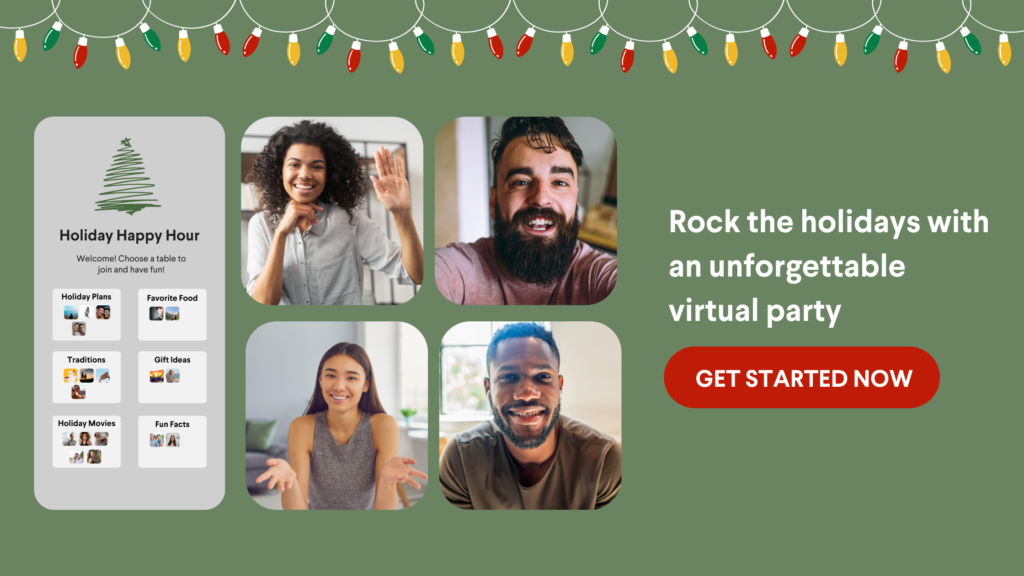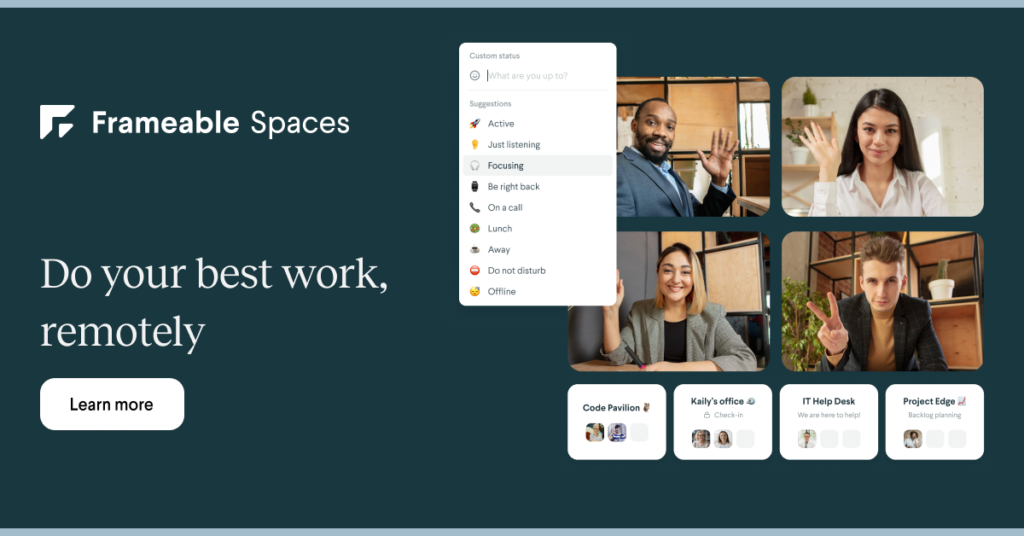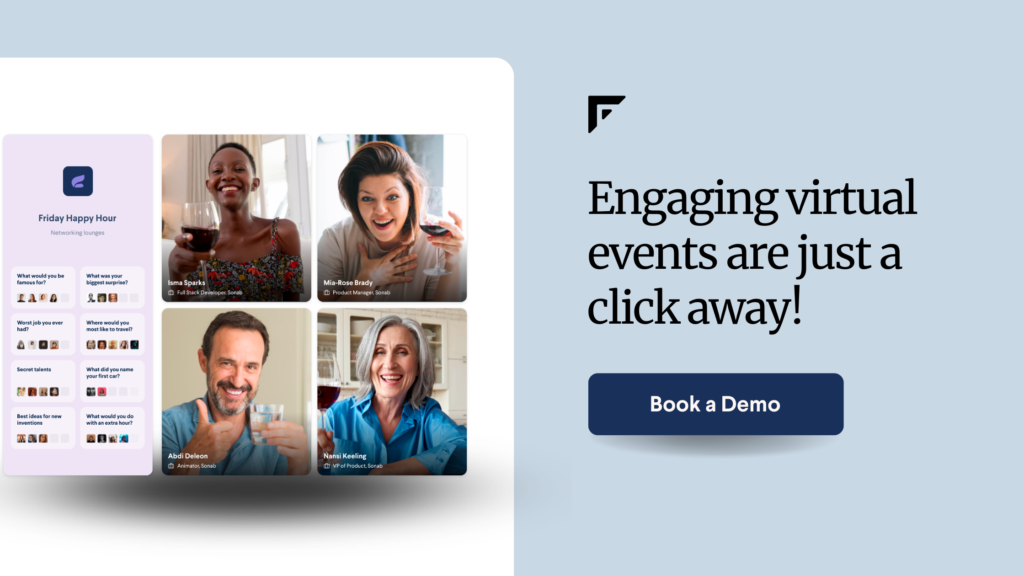The holidays are just around the corner! Is your team planning a workplace holiday celebration?
Although many work holiday parties were curtailed in 2020, teams now have a much better understanding of how to host a fulfilling online team event—and that includes the classic workplace holiday party.
To help your company plan an online holiday party that your team will actually want to attend, let’s explore how you can adapt 10 common holiday party activities for a virtual setting.
Online Workplace Holiday Party Activity Ideas
Before you get too far in your holiday party planning, be sure to talk to your team and understand what they are looking for in a virtual holiday celebration. Gauge the ideal day, time, and length of the party, as well as what activities everyone is interested in and how they’d like to celebrate the season with each other.
While there certainly should be some element of mystery or holiday surprise, you should gently gather the key information to guide your virtual holiday party planning.
Consider adding any of these activities to the lineup to make your virtual holiday party one that your team will love:
Cookie Swap
What says “I appreciate you” more than a homemade or gourmet bakery cookie? Cookie swaps are a holiday-time favorite, and you can easily host a virtual cookie swap during your workplace holiday party.
Depending on how dispersed your team is, you can approach this a few different ways:
- The most straightforward option is to encourage your team members to bake or buy their seasonal favorites and drop them off with a local team member. This person will collect everyone’s baked goods and then mail them out or drop them off. However, this idea works best if your team primarily works out of the same city.
- Alternatively, your team can share holiday cookie recipes for everyone to bake before the party. Then, you can spend a portion of the get-together discussing everyone’s recipes, sharing a story associated with each recipe, and enjoying the baked goods. This option is a perfect one if you have team members with special dietary needs or food allergies.
Cooking or Other DIY Classes
A hands-on cooking lesson or similar crafting or do-it-yourself class—like painting, soap making, or creating air plant terrariums—is a naturally engaging activity for your workplace holiday party. If a member of your team is an outstanding chef with a holiday recipe they’d love to share or a hands-on crafter, ask if they would like to host or co-host the class. Alternatively, you can hire a professional chef or crafter to lead the online activity. If you choose to host this yourself, first determine what DIY activity your team is most interested in and then mail the supplies to them ahead of your party.
Gingerbread Decorating Kits
Do you want a casual activity for everyone to work on as they celebrate the holidays? Host a gingerbread decorating party or competition! Mail gingerbread decorating kits to your team, and have everyone work on their houses throughout the online holiday party. You can create breakout rooms for people to rotate through as they catch up with their colleagues, show off their gingerbread creations, and get some well-deserved catching-up time.
Holiday Virtual Happy Hour
Who’s ready for drinks?! Traditional in-person holiday parties often feature fun and festive drinks for everyone to enjoy. Mail your team non-alcoholic supplies (branded Yeti wine tumblers make a nice gift) plus a BevMo, Costco, or similar gift card for them to purchase alcohol or other beverages. Create recipe cards that explain how to make a few seasonal drinks. Bonus points if your team submits their seasonal favorites for everyone to try! If you need ideas, check out this list of 50 holiday cocktails or these 15 holiday mocktail recipes.
Tabletop Game or Card Game
Sometimes the best holiday party games are the most simple. Consider hosting a tabletop game or a card game for everyone to play in breakout groups. There are 12 potential board games to play in this article, while PlayingCards.io is one option for hosting a virtual card game.
Trivia Game
Trivia is perfect for an online holiday party. Create breakout rooms in your virtual holiday party platform so that each team can collaborate. Designate one spokesperson from each team to share answers, or create Google Forms that teams will submit their answers through. You can host any theme for this trivia. You can keep it holiday-focused with a theme like classic holiday movies, name that holiday tune, or holidays around the world. Or you can explore any theme that will delight your team (and you can ask them during your pre-event planning conversations).
Scavenger Hunt
A virtual scavenger hunt can be a high-energy activity for teams, especially if there is a prize to win. Create a list of items that most of your team members should have at home, including some obscure or lesser-found items. Read off the item and ask everyone to go grab that item if they have it. Whoever returns the fastest wins.
Another way you can approach this game is to deliver a series of clues that will take your team across the internet or throughout locations in their homes. Then, give them 10 minutes to work through the list and take a photo or screenshot of what they think each clue is referencing.
“Ugly Sweater” Contest
It’s not the holidays without a holiday sweater contest. Make your online workplace holiday party a little extra special by encouraging everyone to dress to a theme. Designate a portion of your party for everyone to show off their costumes. You can designate a “winner” based on team votes (just don’t let people vote for themselves).
Virtual Escape Room
Escape rooms skyrocketed in popularity over the past couple of years, especially as a go-to team-building activity. Now, you can host a virtual escape room, too! Check out this article for 24 possible rooms to explore, with details on pricing for each.
Virtual Holiday Party Gift Exchange
A staple of most workplace holiday celebrations is the gift exchange. No matter how your team usually describes its gift-giving—Secret Santa, White Elephant, homemade gifts only—you can easily host a gift exchange during an online holiday party.
Provide pre-paid shipping labels to your team and set a deadline of no longer than 2 weeks before your party for team members to ship their gifts. During the event, take time for everyone to open their gifts, potentially in small-group breakouts if you have many people attending the party.

Pick a Virtual Holiday Party Platform That Puts Your Team At The Heart of the Experience
The ideas we explored are just a few thought starters for hosting an engaging virtual holiday party. Consider these activities when discussing your holiday party plans with your team and gauging what they would like to do.
Throughout your planning, remember the true purpose of an online workplace holiday party: to celebrate your team and provide an optional space to come together.
If you force everyone to attend your holiday party only to maroon them in a sub-par online meeting platform, their holiday spirits will instantly dampen. You need to pick an online event platform that gives your team the flexibility they need to hop in and out of rooms, network in small-group settings, and occasionally join as a full team for any announcements from your leadership (are bonuses on the horizon?).
We’ve built Frameable Events to host engaging online holiday parties for teams of all sizes. Our platform allows you to create fully customizable holiday events with networking spaces, full-group discussion spaces, and intuitive features that your team will love. Book a demo to see how easy it is to host your holiday party with Frameable Events.













